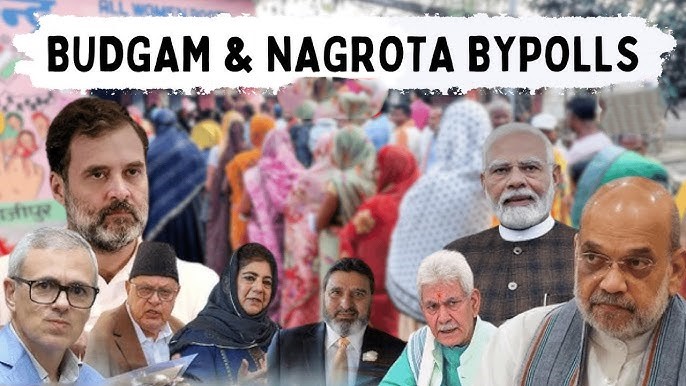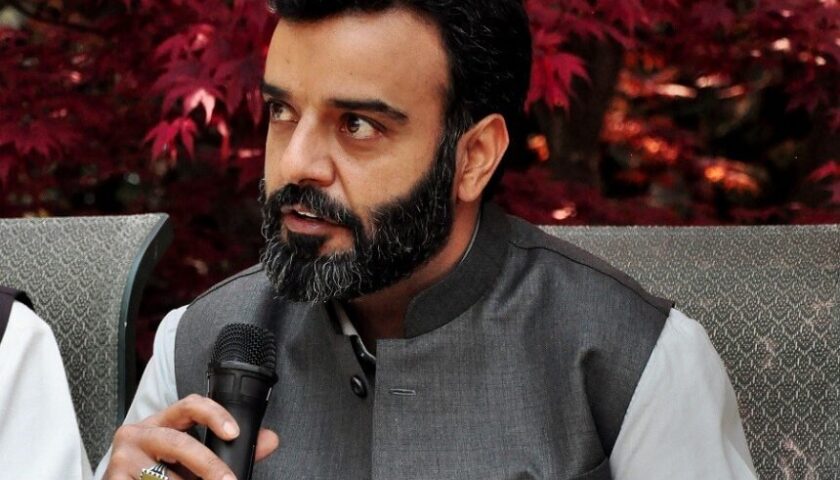J&K Bypoll Results Deliver Split Verdict as PDP Wins Budgam and BJP Secures Nagrota
By: Javid Amin | 14 November 2025
The by-elections in Jammu & Kashmir on Sunday produced a split verdict, with the PDP winning the Budgam seat in central Kashmir and the BJP retaining Nagrota in the Jammu region. The contrasting outcomes highlight the continued political divergence between the Kashmir Valley and the Jammu region.
PDP’s Aga Muntazir Wins Budgam, Defeats NC in a Close Contest
In Budgam, PDP candidate Aga Syed Muntazir Mehdi emerged victorious with 21,576 votes, defeating National Conference (NC) candidate Aga Syed Mehmood by a margin of 4,478 votes. The turnout in the constituency was just over 50%, lower than in many recent elections but consistent with central Kashmir’s voting patterns.
The seat was previously held by Omar Abdullah, who vacated it after winning from the Ganderbal Assembly constituency earlier this year. The outcome is being seen as a significant morale boost for the PDP, which has been attempting to rebuild its organizational base and reconnect with voters after major setbacks since 2018.
Political observers note that the victory indicates the PDP’s localized influence remains intact, particularly among traditional support groups. It also signals increased competitiveness in constituencies previously considered stable for the NC.
BJP’s Devyani Rana Clinches Nagrota in High-Turnout Election
In Nagrota, BJP candidate Devyani Rana secured a decisive win with 42,350 votes, defeating J&K National Panthers Party (JKNPP) President Harsh Dev Singh. The constituency recorded a 75.08% turnout, the highest among all bypoll seats.
Nagrota had fallen vacant following the death of senior BJP leader Devender Singh Rana, Devyani’s father. While the sympathy factor contributed to her campaign, analysts credit the BJP’s strong organizational network and consistent voter engagement across Jammu for the emphatic victory.
The result reinforces the BJP’s dominant position in the Jammu region, which it has maintained over multiple elections despite shifts in national political dynamics.
A Split Verdict with Clear Regional Undercurrents
The two contrasting results underscore the deep regional divide that has shaped J&K’s electoral landscape for decades but appears even more pronounced after the reorganization of the former state in 2019.
-
The Kashmir Valley appears to be leaning toward regional parties with more localized, grassroots narratives—evident in the PDP’s win over NC.
-
The Jammu region, meanwhile, continues to remain firmly aligned with the BJP’s broader national agenda.
This divergence suggests that no single political formation currently holds uniform influence across the Union Territory.
Implications for Key Political Players
For PDP:
The Budgam victory offers a much-needed revival signal for the party. It strengthens PDP’s claims of reconnecting with public sentiment and could help restore its bargaining power in future electoral negotiations.
For NC:
The loss in a seat vacated by Omar Abdullah raises strategic questions. Analysts say the NC may need to reassess its approach in central Kashmir, where it previously held strong.
For BJP:
The Nagrota win reaffirms the party’s entrenched position in Jammu, despite recent intra-party turbulence, including controversies around Rajya Sabha cross-voting. The result demonstrates continued voter confidence in the BJP’s regional leadership.
What Comes Next
While these were only two by-elections, the results serve as an early indicator of emerging political trends as J&K moves closer to larger and more consequential elections in the coming year. Parties are expected to recalibrate their strategies based on the underlying signals from both Budgam and Nagrota.
Split Verdict, Sharper Faultlines: What Budgam and Nagrota Say About J&K’s Political Direction
The by-elections in Budgam and Nagrota did more than fill two vacant Assembly seats—they revealed the current mood of the electorate, the limits of political influence, and the deepening regional contrasts that define Jammu & Kashmir today.
On the surface, the results appear routine: a PDP win in the Valley and a BJP win in Jammu. But beneath the numerical margins lies a story of political resurgence, setbacks, and recalibration.
PDP’s Budgam Victory: A Vote for Political Relevance
Aga Muntazir’s victory in Budgam is not merely a seat gain; it is a statement. For the first time in years, the PDP can genuinely claim that the ground beneath its feet is no longer slipping. The party has, since 2018, struggled with fragmentation, defections, public distrust, and a crisis of leadership.
Yet Budgam shows the party is not only alive but competitive.
The victory says three things:
-
Local credibility matters more than party-level baggage.
Aga Muntazir’s personal network and community ties outweighed the NC’s organizational reach. -
NC’s central Kashmir dominance is not guaranteed.
The seat Omar Abdullah vacated was considered “safe.” It no longer is. -
Voters are willing to reward reconnecting efforts.
PDP’s quieter, less theatrical ground engagement seems to be resonating.
This win may be a small step numerically, but politically, it is a psychological breakthrough for PDP.
NC’s Setback: A Warning Shot
For the National Conference, Budgam is not a catastrophe but a caution sign. A party that prided itself on central Kashmir strongholds now faces an unsettling question: Are those strongholds still strong?
The result could indicate:
-
Disillusionment with status quo politics
-
Fatigue with leadership narratives
-
A desire for local-level responsiveness rather than legacy politics
NC will need more than historic goodwill to retain its influence in the future.
BJP’s Nagrota Triumph: Stability in Unstable Times
Across the Pir Panjal, Nagrota delivered the BJP a comfortable and unsurprising victory. But the significance of this win should not be underplayed.
In a year marked by internal dissension, cross-voting controversy, and leadership tremors, the BJP’s base in Jammu has proven unshaken.
Three messages emerge:
-
Jammu’s support for the BJP is structural, not seasonal.
It is rooted in identity, development claims, and a stable organizational presence. -
The sympathy factor added momentum—but wasn’t the foundation.
Devyani Rana benefited from her father’s legacy, but the BJP machinery ensured turnout and consolidation. -
Opposition fragmentation in Jammu strengthens BJP’s dominance.
Harsh Dev Singh’s challenge lacked the coalition support needed to dent BJP’s stronghold.
Nagrota reinforces that the Jammu region remains the BJP’s political anchor in J&K.
The Larger Picture: A Divided Union Territory with Diverging Priorities
Perhaps the most important takeaway is the deepening regional divergence:
-
Valley voters appear to be gravitating toward parties that foreground local grievances and regional identity.
-
Jammu voters continue to align with a national political framework.
This split is not new—but it is more pronounced today than at any time in the last decade.
What the Split Verdict Really Reveals
The results reveal a Union Territory in transition:
-
Voters are experimenting, not committing.
-
No party owns the political space fully.
-
Local dynamics outweigh national narratives in the Valley.
-
National narratives still dominate in Jammu.
If this trend continues, the next full-fledged election in J&K will not just be competitive—it will be unpredictable.
Bottom-Line: A Political Reset in Motion
The Budgam–Nagrota bypolls may not determine political power, but they unquestionably determine political momentum. PDP walks away with renewed confidence. BJP reaffirms its regional command. NC is forced back to the strategy table.
The electorate has sent a message:
Power in J&K can no longer be taken for granted. It must be earned constituency by constituency.




